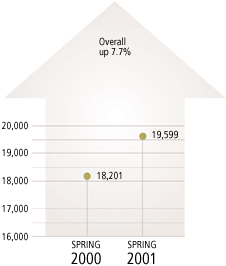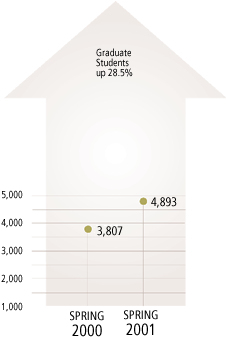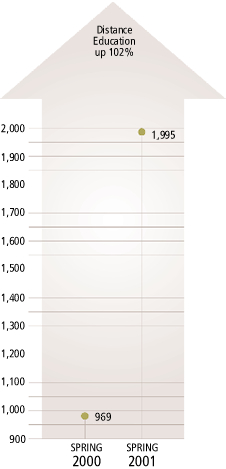|
Graduate students like Ruby Ruperto and her Contemporary Science
classmates significantly boosted University enrollment for spring
2001, the fifth consecutive semester of enrollment increases.

Overall enrollment rose from 18,201 in spring 2000 to 19,599 in
spring 2001, a 7.7 percent jump. But it was graduate students who
made the biggest impact. In that same period, the number of new
graduate students climbed from 585 to 840, a dramatic 43.6 percent
increase. Overall graduate enrollment rose from 3,807 to 4,893,
up 28.5 percent.

In January, Ruperto, who teaches seventh-grade science at Arlington’s
Ousley Junior High School, began classes in the College of Science’s
new master of arts in interdisciplinary science program. Designed
for science teachers, the new degree offers innovative teaching
ideas and state-of-the-art technology training.

“I needed to update my science knowledge and catch up with
technology,” she said. “So far, I’m thoroughly impressed
with my professors. Plus, UTA has been very accommodating with the
class schedule and tuition.”
Programs tailored for nontraditional students and working professionals
like Ruperto are credited in large part with the increase in graduate
students.
“We’ve added an M.B.A. program for employed professionals,”
explained Dana Dunn, vice president for academic affairs. “We’ve
also increased the number of niche programs that are responsive
to students who have heavy schedules.
“We’re now seeing the results of initiatives we put in
place several semesters ago. Our expectation is that we’ll
see it build and build over time.”
Jeff Morton enrolled two years ago, but he and other continuing
students also play an important part in enrollment—retention.
“We’re working very hard to ensure that students who come
into the University are successful and stay,” Dr. Dunn said.
Morton, who’s working on his master’s degree in education,
lived in Taiwan for two years and was introduced to the many worldwide
opportunities for teachers. After another international adventure
studying Spanish in Costa Rica, he returned to the states and enrolled
in UTA.
“There were other programs I could have chosen, but here I
get an excellent education, it’s close to home, and they’re
willing to be flexible about work and scheduling,” he said.
“Plus there are more nontraditional students here, like me.”
Additional recruitment and retention efforts, specifically designed
to meet the needs of multicultural student groups, are credited
with the increase in African-American enrollment, up 17.8 percent,
and Hispanic enrollment, up 18.6 percent from a year ago.
And distance education, with enrollment numbers up an impressive
102 percent, also brought new students to UTA this spring, if only
in a virtual sense. In this area, like the others, flexibility and
convenience played the biggest role.
“Many of our students are trying to balance jobs, family,
school and other commitments,” said Pete Smith, assistant vice
president and director of distance education. “As time goes
on, we’re offering more and more online degrees and courses.
This allows students to choose when they take classes and to work
school into their busy schedules.”
– SWN
|

